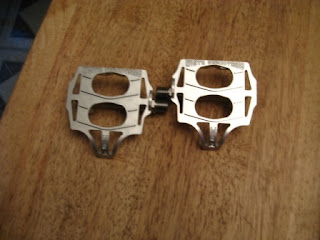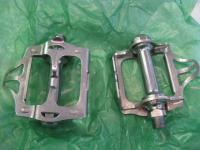If you have been cycling for a while, chances are that you've ridden at least one pair of Lyotard pedals. Perhaps you still are.

All Peugeots, and most other French bikes that weren't equipped with Campagnolo components, came with one Lyotard model or another as standard equipment. Even a few Campy-equipped bikes had Lyotard pedals--at least, one particular model I'll mention in a minute.
Lyotards were also found on bikes from other countries---yes, even a few from Japan, which probably has had more pedal-makers than any other nation. There is a good reason why Lyotards were so common: They offered a wide range of intelligently-designed products, and they offered good quality at a reasonable price.
The three most popular models were probably the Nos. 460, 136R and 23.
No. 460 was an alloy double-sided, sawtoothed "rat trap" pedal popular with Cyclo-Cross riders, cyclo-tourists and bicycle commuters. They were usually silver, but for a time were offered with blue, red or black anodizing. The 136 was a less-expensive steel pedal with curvy plates that often had reflectors built into them. It was standard equipment for many years on the Peugeot U0-8, Motobecane's Nobly and Mirage, and other lower-priced French machines popular during the '70's Bike Boom.
But Lyotard's most iconic product was probably the No. 23, also known as the Marcel Berthet pedal. You've probably seen the 23, if you haven't used it yourself: It's the one with the flat platform and the "tongue" that makes toe clip entry easier. It's the pedal that inspired the MKS GR-9, GR-10 and Urban Platform pedals, as well as White Industries' amazing Urban Platform pedals.
It's no surprise, really, that the 23 would inspire other pedals: It is among the most elegant pieces of cycling equipment ever made. And, oh yes, it's comfortable and is still a relatively light pedal, especially for one constructed entirely from steel. For those reasons, and for its cornering clearance, it was sometimes found on otherwise all-Campagnolo bikes.
Lyotard started to make pedals in 1921 and continued until 1992 or thereabouts. The qualities I've mentioned--good value for the money and a wide range--are probably what kept the company in business for seven decades. However, they, like many other French component makers (such as Simplex), failed to innovate or even update their lineup. Cheaper Asian imports took away much of the market share the 136--and, to a lesser extent, the 460-- held. The Berthet/No.23 was seen as a "cult" item, and the development of easy-to-use clipless pedals from Look and Time all but ended the demand for high-quality traditional pedals, which included the No. 45: the pedal that came with the Peugeot PX-10.
Lyotard finally came out with a clipless pedal, the PL 2000, in 1989, half a decade after Look first came to market. I don't know anyone who actually used the PL 2000, but the design looks interesting. Essentially, the pedal is really just an axle with a spring-loaded cap on the end opposite the pedal threads. The cleat had a groove into which the axle fit when the rider "clipped in"; the spring-loaded cap held the rider's foot onto the pedal. The rider would slide her or his foot outward to push the spring-loaded cap aside and disengage her or his foot from the pedal.
For all I know, it may have worked very well. And, if nothing else, it was probably a very light weight pedal. But I have to wonder how (un)comfortable it was: Look and Time pedals at least have something resembling platforms that provide more surface contact area.
Also, Lyotard's cleat was proprietary. You couldn't mount it on a shoe drilled for Look or other cleats that were using Look's three-bolt mounting system, which quickly became the standard for road clipless pedals.
Even if Lyotard's system had caught on, it might not have been enough to save a company with one of the longest histories in cycling. But at least its legacy lives on in some pedals produced today: the Berthet/No.23 has directly inspired the MKS and White Industries pedals I've mentioned and, perhaps indirectly, almost any pedal designed with aerodynamics (or pretentions thereof) in mind. Such pedals would include most road clipless pedals. And the MKS Sylvan --very popular with tourists and commuters--echoes, in many ways, the 460.
All Peugeots, and most other French bikes that weren't equipped with Campagnolo components, came with one Lyotard model or another as standard equipment. Even a few Campy-equipped bikes had Lyotard pedals--at least, one particular model I'll mention in a minute.
Lyotards were also found on bikes from other countries---yes, even a few from Japan, which probably has had more pedal-makers than any other nation. There is a good reason why Lyotards were so common: They offered a wide range of intelligently-designed products, and they offered good quality at a reasonable price.
| No. 460 |
The three most popular models were probably the Nos. 460, 136R and 23.
| No. 460 en bleu |
No. 460 was an alloy double-sided, sawtoothed "rat trap" pedal popular with Cyclo-Cross riders, cyclo-tourists and bicycle commuters. They were usually silver, but for a time were offered with blue, red or black anodizing. The 136 was a less-expensive steel pedal with curvy plates that often had reflectors built into them. It was standard equipment for many years on the Peugeot U0-8, Motobecane's Nobly and Mirage, and other lower-priced French machines popular during the '70's Bike Boom.
| No.136R |
But Lyotard's most iconic product was probably the No. 23, also known as the Marcel Berthet pedal. You've probably seen the 23, if you haven't used it yourself: It's the one with the flat platform and the "tongue" that makes toe clip entry easier. It's the pedal that inspired the MKS GR-9, GR-10 and Urban Platform pedals, as well as White Industries' amazing Urban Platform pedals.
 |
| No. 23, a.k.a. Marcel Berthet |
It's no surprise, really, that the 23 would inspire other pedals: It is among the most elegant pieces of cycling equipment ever made. And, oh yes, it's comfortable and is still a relatively light pedal, especially for one constructed entirely from steel. For those reasons, and for its cornering clearance, it was sometimes found on otherwise all-Campagnolo bikes.
| No. 45 |
Lyotard started to make pedals in 1921 and continued until 1992 or thereabouts. The qualities I've mentioned--good value for the money and a wide range--are probably what kept the company in business for seven decades. However, they, like many other French component makers (such as Simplex), failed to innovate or even update their lineup. Cheaper Asian imports took away much of the market share the 136--and, to a lesser extent, the 460-- held. The Berthet/No.23 was seen as a "cult" item, and the development of easy-to-use clipless pedals from Look and Time all but ended the demand for high-quality traditional pedals, which included the No. 45: the pedal that came with the Peugeot PX-10.
| PL 2000 |
Lyotard finally came out with a clipless pedal, the PL 2000, in 1989, half a decade after Look first came to market. I don't know anyone who actually used the PL 2000, but the design looks interesting. Essentially, the pedal is really just an axle with a spring-loaded cap on the end opposite the pedal threads. The cleat had a groove into which the axle fit when the rider "clipped in"; the spring-loaded cap held the rider's foot onto the pedal. The rider would slide her or his foot outward to push the spring-loaded cap aside and disengage her or his foot from the pedal.
For all I know, it may have worked very well. And, if nothing else, it was probably a very light weight pedal. But I have to wonder how (un)comfortable it was: Look and Time pedals at least have something resembling platforms that provide more surface contact area.
Also, Lyotard's cleat was proprietary. You couldn't mount it on a shoe drilled for Look or other cleats that were using Look's three-bolt mounting system, which quickly became the standard for road clipless pedals.
Even if Lyotard's system had caught on, it might not have been enough to save a company with one of the longest histories in cycling. But at least its legacy lives on in some pedals produced today: the Berthet/No.23 has directly inspired the MKS and White Industries pedals I've mentioned and, perhaps indirectly, almost any pedal designed with aerodynamics (or pretentions thereof) in mind. Such pedals would include most road clipless pedals. And the MKS Sylvan --very popular with tourists and commuters--echoes, in many ways, the 460.







